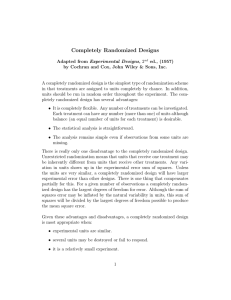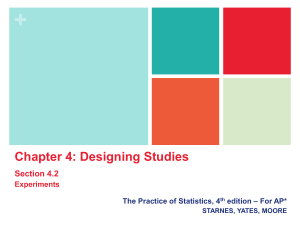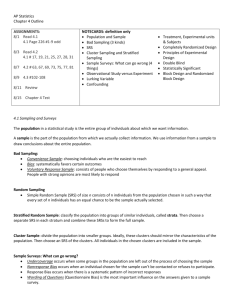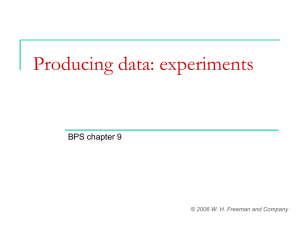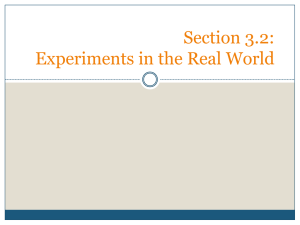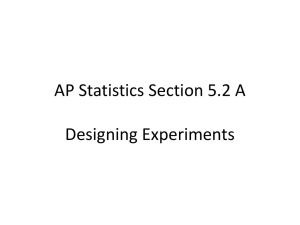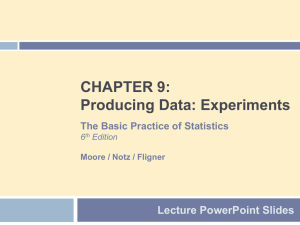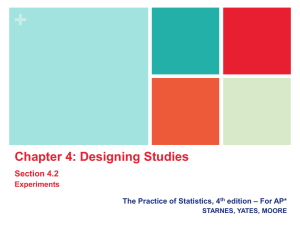5-2 Day 1
advertisement
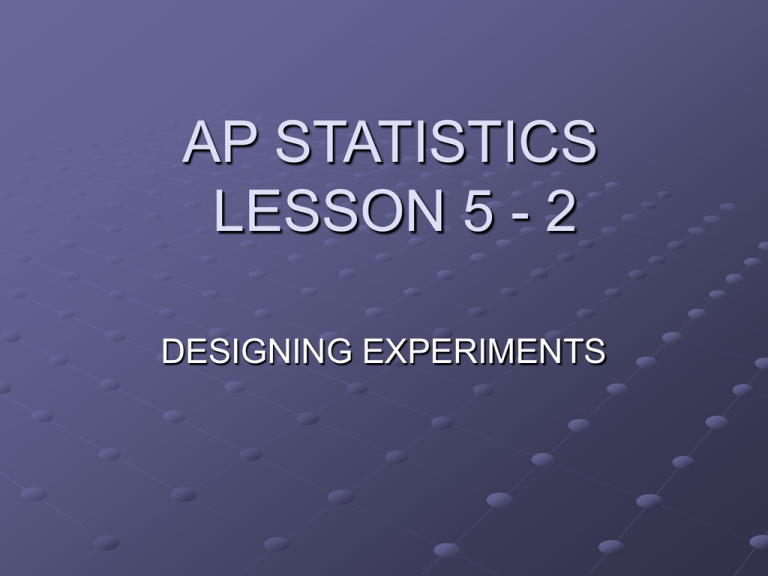
AP STATISTICS LESSON 5 - 2 DESIGNING EXPERIMENTS ESSENTIAL QUESTION: How is a good experiment designed? Objectives: To understand and use the statistical vocabulary involved in designing experiments. To design experiments that come as close as possible to eliminating lurking variables and bias. Experimental Units, Subjects, Treatment A study is an experiment when we actually do something to people, animals, or objects in order to observe the response. The individuals on which the experiment is done are the experimental units. When the units are human beings, they are called subjects. A specific experimental condition applied to the units is called a treatment. Additional Vocabulary The explanatory variables in an experiment are often called factors. In such an experiment, each treatment is formed by combining a specific value (often called a level) of each of the factors. A placebo is a dummy pill that creates a situation so the experimenter can see what the effect of the subject will be just by being treated. Experiments In principle, experiments can give good evidence for causation. Experiments have the advantage of allowing us to study the specific factors we are interested in, while controlling the effects of lurking variables. Experiments also allow us to study the combined effects of several factors. The interaction of several factors can produce effects that could not be predicted from looking at the effects of each factor alone. Outlining a designed Experiment Units Treatment Observed response Page 290 Example 5.9 THE PHYSICIAN’S HEALTH STUDY Comparative Experiments Placebo effect (a dummy treatment) – Many patients respond favorably to any treatment, even a sugar pill. Control group – The group that receives the sham treatment (placebo). We rely on the controlled environment of the laboratory to protect us from lurking variables. Control is the first basic principle of statistical design of experiments. Comparison of several treatments in the same environment is the simplest form of control. Control Without control, experimental results in medicine and the behavioral sciences can be dominated by such influences as the details of the experimental arrangement, the selection of subjects, and the placebo effect. The result is often bias, systematic favoritism toward one outcome. Randomization The design of an experiment first describes the response variable or variables, the factors (explanatory variables), and the layout of the treatment, with comparison as the leading principle. Experimenters often attempt to match the patients in one group with similarities in the control group with elaborate balancing acts. The statistician’s remedy is to rely on chance to make an assignment that does not depend on any characteristic of the experimental units and does not rely of the judgment of the experimenter in any way. Randomized Comparative Experiments Randomization produces groups of units that should be similar in all respects before the treatments are applied. Comparative design ensures that influences other than the response variable operates equally for both groups. Therefore, differences in response variable must be due either to the variable factors or to the play of chance in the random assignment of units. Principles of Experimental Design The basic principles of statistical design of experiments are: 1. Control the effects of lurking variables on the response, most simply by comparing two or more treatments. 2. Randomize – use impersonal chance to assign experimental units to treatments. 3. Replicate each treatment on many units to reduce chance variation in the results. Statistical Significance An observed effect so large that it would rarely occur by chance is called statistically significant. You will see the phrase “ statistically significant” in reports of investigations in many fields of study. It tells you that the investigators found good evidence for the effect they were seeking. When all experimental units are allocated at random among all treatments the experimental design is completely randomized. Cautions About Experimentation The logic of a randomized comparative experiment depends on our ability to treat all the experimental units identically in every way except for the actual treatments being compared. Many behavioral science experiments use as subjects students who know they are subjects in an experiment. That’s not a realistic setting (lack of realism). Matched Pairs Design Match pairs designs compare just two treatments. Completely randomized designs are the simplest statistical designs for experiments. However, completely randomized designs are often inferior to more elaborate statistical designs. In particular, matching the subjects in various ways can produce more precise results than simple randomization. Blocking Designs Matched pairs is an example of blocking design. A block is a group of experimental units of subjects that are known before the experiment to be similar in some way that is expected to affect the response to the treatment. In a block design, the random assignment of units to treatments is carried out separately within each block. Double – Blind Experiment In a double-blind experiment neither the subjects nor the people who have contact with them know which treatment a subject received.

